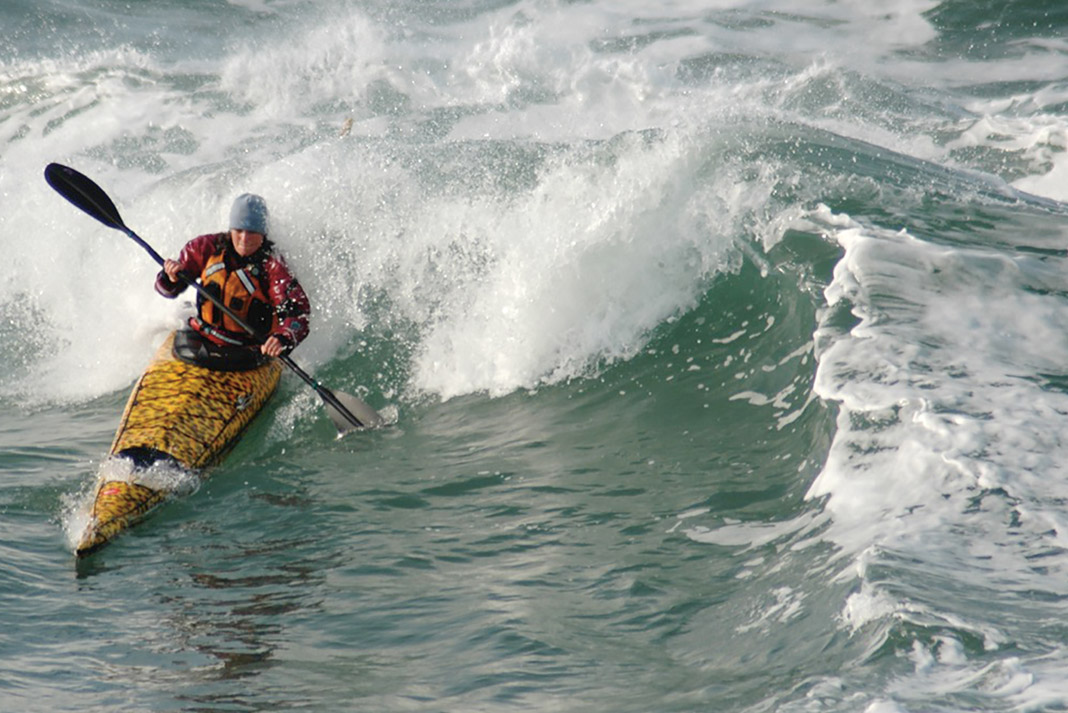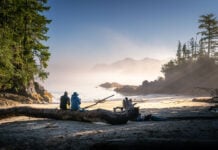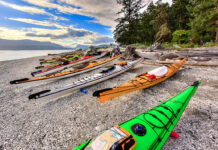“Sea kayaking. Isn’t that men with beards enjoying nature?” asks the voiceover
Then Justine Curgenven, Trys Burke and Gemma Rawlings peel off their fake beards, strip down to bikini tops, paddle into the tidal race of Penryhn Mawr and surf up a storm. The voiceover continues: “I wanted to make a sea kayaking film to show that sea kayaking is exciting and dynamic.”
It’s Been 14 Years Since Justine Curgenven Released This Is The Sea, Which Was Heralded As The First-Ever Sea Kayaking Action Film. It’s a short time span for a retrospective, but the film could also have been titled This Is The Sea Change in Sea Kayaking.
When the first feature-length film in the five-part series was released, I gathered my paddling pals to watch it. During the screening our excitement bubbled over like a wave surging through a rock garden. Someone had finally captured the paddling we did on the Oregon coast and the Columbia Gorge.
In hindsight, I see how much influence it had,” Curgenven recently told me from her new home on Vancouver Island’s west coast. “At the time I didn’t see it, but people who were already doing exciting paddling suddenly had a vessel to communicate what they do. And other people said, ‘Wow you can do that in a sea kayak? That’s really cool!’
A rock had been thrown into the paddling pond—following This Is The Sea’s big splash waves rippled in all directions. Over the next few years advertisements in kayak magazines morphed from depicting mostly peaceful flatwater scenes to action-oriented photos. Instruction shifted as surf expanded its turf. Manufacturers began designing and marketing specialty ocean-play kayaks. This Is The Sea inspired the creation of more rough water films, most notably Pacific Horizonsand Eastern Horizonsby Bryan Smith, before he went off to work for some obscure outfit called National Geographic.
This Is The Sea Also Put Women At The Forefront Of Sea Kayaking
“I didn’t do it for women’s rights; I did it because I love doing it. I just happen to be a woman,” says Curgenven. But her adventures and the women she featured in her nine films inspired others. “It made women say, ‘Damn, if she can do it, then I can do it as well.’”
This Is The Sea wasn’t the first foray into rough water sea kayaking. Remember the Tsunami Rangers, who wore hockey-style body armor while paddling the northern California and Southern Oregon coast back in the 1980s? However, This Is The Sea struck a chord. Curgenven’s wide-eyed enthusiasm, disarming and distinctive cackle, and masterful strokes gained a following. Her films weren’t only dedicated to surfing the gnar, the series had compelling characters and narratives.
“The Films All Have A Mixture Of Different Stories,” Curgenven Told Me
“The first concentrated on rough water because it was important to show that aspect. The others had destinations and characters, as well as rough water.”
Segments focused on traditional Greenland kayaking, and less dramatic destinations like Florida, the Mediterranean and the Great Lakes, as well as rock gardens, tide races, surf play and expeditions.
And, like surfing a wave, timing and take-off point mattered. In 2004, Internet video was just coming into to its own. Curgenven filmed with a video camera mounted on an arm custom-made by Lendal, and wired to a heavy box holding the camera’s processing unit inside the hatch. Spare batteries filled up more hatch space. Clunky and low-res by today’s standards, it was groundbreaking for the early millennium.
“In hindsight, it was really good timing, a bit ahead of its time. I had a crappy website and a one-minute cut, but if people wanted to see exciting sea kayaking stories they bought my videos,” Curgenven says. Now, with the Internet awash in free videos and GoPros on every helmet, she’s turning away from filmmaking. “I haven’t made a film for two years. I don’t know if I am going to,” she says. “Right now, I’d rather go kayaking.”
Even If We Never See A New Film Featuring Curgenven’s Signature Cackling Laugh, The Influence Of This Is The Sea Is Undeniable
“We were trying to shake it up a bit,” she admits. “But the old guys with beards are still okay by me, too.”
Neil Schulman writes about sea kayaking’s past and future in Reflections.









